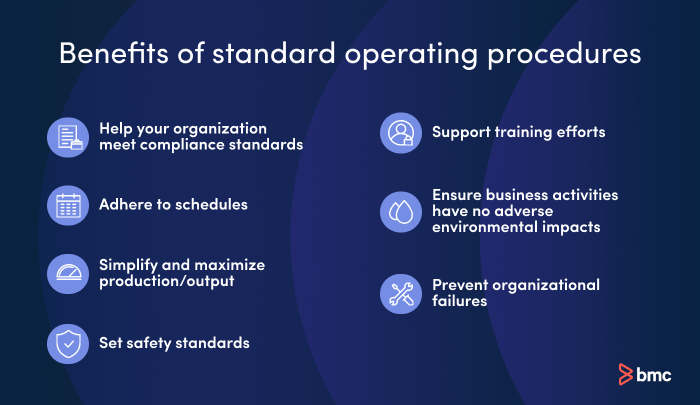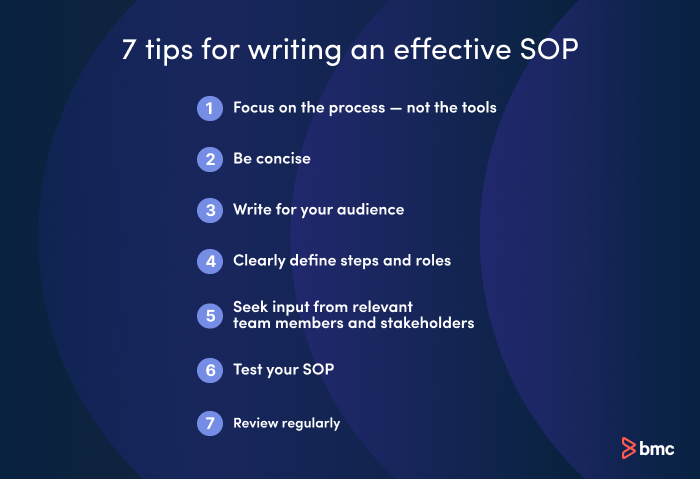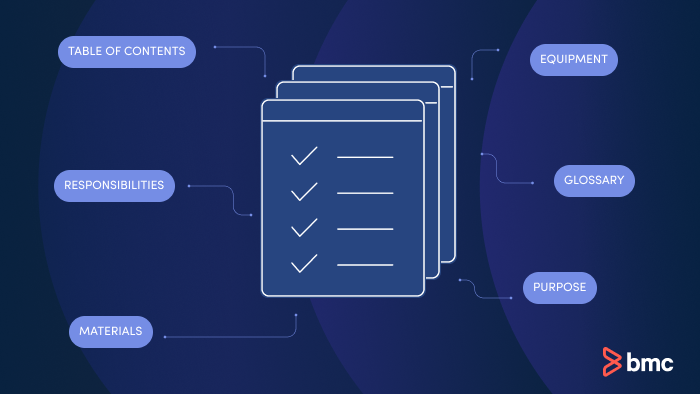I often help customers automate their business processes with Server Automation. I start by gathering information about the process. In many cases, people do not know how the entire process works. They will know their step in the process very well, and everything goes smoothly—until it doesn’t.
For example, an employee leaves for vacation. Will their stand-in be able to complete the tasks? A new worker joins the company. How will they learn the process? A standard operating procedure, or SOP, makes it possible for work to continue smoothly in these scenarios. An SOP is also a go-to resource for when questions arise.
Businesses and teams of all types regularly find themselves in need of writing an SOP, or standard operating procedure. In this article, we’re exploring the basics of SOPs, including:
- What is a standard operating procedure (SOP)?
- The benefits of SOPs and SOP libraries
- What should an SOP include?
- Steps for writing your SOP
- SOP tips and best practices
- Examples of industries that use SOPs
What is a standard operating procedure (SOP)?
A standard operating procedure, or SOP, comprises the specified tasks, processes, and order of completion to be followed to consistently and efficiently produce high-quality outputs.
When automating a business process, one of the first things to look for is an SOP. IBM defines an SOP simply as “a set of instructions that describes all the relevant steps and activities of a process or procedure.” It’s crucial that organizations know what is needed to complete certain tasks or processes, and an SOP offers that guidance.
An SOP lays out the tasks and roles needed to achieve a policy outcome. This removes the reliance on one person to know how to complete a task, or a set of related tasks. Anyone can consult a single SOP or a group of related SOPs to determine what steps are needed.
What’s the purpose of an SOP?
Having an SOP serves multiple purposes. The clarity and consistency of a thoughtful and well-documented SOP provides efficiency, speeds things up, prevents errors, reduces costs, and, in some situations, enhances safety. Workers avoid stress, confusion, and burnout.
Used correctly, an SOP describes in detail the implementation of a business policy. Typically, it:
- Establishes a purpose and goal for the SOP
- Specifies the scope of the work
- Fulfills policy requirements such as regulatory policies, internal standards, and/or industry best practices
- Maps the applicable policy, standards, and practices to an explicit, step-by-step set of actions
- Defines the goals that the process will accomplish, and breaks these into individual steps to achieve that goal
- Assigns the roles responsible for carrying out each step
- Includes documentation, forms, tools, and equipment
It is just as important to understand what an SOP is not: SOPs are not work instructions (WI), which contain specific directions for using specific tools. Work instructions flow from the steps of an SOP — an SOP describes what needs to be done, and a WI describes how it is done.
Benefits of standard operating procedures

Broadly speaking, an SOP takes organizational policies, goals, missions, and visions and turns them into actions. The SOP gives tangible, real-world guidance to help put appropriate policies into place. In addition, it helps to provide consistency in how tasks are executed throughout an organization.
More specifically, there are a number of organizational benefits that SOPs offer:
- Help your organization meet compliance standards
- Adhere to schedules
- Simplify and maximize production/output
- Set safety standards
- Support training efforts
- Ensure business activities have no adverse environmental impacts
- Prevent organizational failures
The business value of an SOP library
As you create SOPs, you are also creating a library — a place to reference all of your operating procedures. A single SOP is useful to the people directly involved in that task, but an entire body of SOPs provides high-level context and shows how tasks are related. A library of SOPs provides many benefits, such as:
- Helps workers define and learn their role and responsibilities
- Promotes consistent outcomes
- Delivers a key step in the implementation and verification of business policies
The SOP guides employees in learning what is expected of them and how to fulfil their responsibilities. It also helps other groups and roles understand their actions in the larger context of the company. By assigning a role to each step, the SOP ensures the correct people/teams are completing the right steps toward a goal.
Finally, an SOP library ensures that business policies are implemented and tasks are performed according to the work instructions. SOPs support a cycle from policy to SOP to WI, and, ultimately, output of the policy.
What should an SOP include?
Key parts and components of a typical SOP include:
- Title. A concise and descriptive title reflects the SOP’s purpose and makes it easy to find. You may catalog it with an ID number and add a creation and revision date. Additional helpful information includes division, department, role, and possibly information about the author and person approving it.
- Table of contents. Make it easy for the reader to find information, with a guide to each section.
- Purpose. Explain the goal of the SOP and desired results.
- Materials and equipment. Specify the hardware, software, and other materials that may be necessary to the task.
- Glossary. Define terms, jargon, acronyms, and abbreviations to enhance clarity.
- Responsibilities. Specify the personnel, skills, and roles needed for the procedure.
- Tasks and steps. This section is where the ordered work steps are specified, along with notes about dependencies, precautions that may be needed, and other such details.
- Documentation. Include details about record keeping, retention times, and necessary paperwork.
- References. Complicated or regulated procedures may need standards and guidelines. Health and safety warnings may also be required.
The process for writing an SOP
The process for writing an SOP is unique for each organization, so it’s important to find a drafting process that fits your team’s specific needs. Rather than getting overwhelmed by the idea of this process, utilize these tips and steps to put together a plan. Once you’ve developed a thorough plan and system, trust that system to help you prepare an effective SOP that your team can utilize.
Of course, there are a few things that you should always consider when starting to write your SOP:
- First and foremost, make your SOP easy to read, understand, and use. If not, it won’t be utilized and, thus, won’t be effective.
- Make your SOP actionable. Your audience should know exactly what actions to take to meet the specific task or goal.
- Make your SOP specific and measurable. This will ensure that you can evaluate the effectiveness of a process while adjusting as necessary.
Guided by these three SOP principles, here are the steps you can follow when preparing your SOP:
Keep the end objective in mind
When you’re ready to draft your SOP, start with the end in mind. Consider what you want the SOP to achieve and all activities, from beginning to end, that are necessary to meet this objective.
To help, consider mapping out the activities with a flowchart or diagram to help understand every aspect of the process. Doing so should give you an outline, scope, and sequence of the relevant procedure.
Balance depth and usability
From your outline, you should have a clear understanding of each step of the process. It’s important, however, to consider which steps can be combined, which can be eliminated, and which ones need to be expanded.
One of the most challenging aspects of drafting an SOP is ensuring that it has enough detail to be usable by your audience, but not so much detail that your audience doesn’t want to use it. Experts recommend having 5-7 steps per SOP. Before writing your SOP, work to ensure that your outline has adequate detail but not so many steps or so much depth that it’s overwhelming and unusable.
Draft the SOP
Once you’ve revised your outline and any applicable flow charts or diagrams, it’s time to draft the SOP.
Consider the list of typical SOP sections and decide which ones are necessary for the procedure. The more complicated or mission-critical the SOP, the more detail to provide.
The next step is to decide on an SOP format. Typical SOP formats lay out the SOP step-by-step, creating a hierarchy of steps, or laying out a flowchart of steps. Each option has its strengths and weaknesses and no single style is perfect for all procedures.
7 tips for writing an effective SOP
What makes a good SOP? To fully reach its potential, an SOP should have the following characteristics:

1. Focus on the process—not the tools
An SOP should focus on the process, so try to be tool- or software-independent. As we stated earlier, SOPs are unlike work instructions (WI). Work instructions are tool-specific instructions, whereas our SOP is the process.
For example, a customer wants to automate the process of promoting software to a testing environment for proper testing. An SOP may have these steps:
- Developers notify release engineers when code is ready to be tested.
- Release engineers copy code to the test environment from the development environment.
- Release engineers notify QA team that the code is ready to be tested.
The WIs that would flow from this SOP will be instructions around using tools such as FTP to transfer the code, and so on. To automate this, I follow the same process and use Server Automation where possible. The process stays the same, but the WIs will be different, as they’ll reflect the new tools.
2. Be concise
An SOP should be short, readable segments that describe how to accomplish a specific task. If there are too many steps, consider splitting sub-tasks into separate SOPs that reference each other. This results in SOPs that are easier to read and understand, and you’ll already have a working SOP library.
For example, a customer may have an SOP that describes the entire software development lifecycle process, starting with initial development through testing and deployment to production. This is a large process with many steps. Realistically, a reader seeking guidance on promoting code to production would not be interested in initial code development. A targeted SOP on migrating code to production would let the reader stay focused on this specific task.
Some logical break points in this software development process example could be:
- Develop code in development environment.
- Promote code to testing environment for proper testing.
- Promote code to production.
Each of these break points could be covered by its own shorter, easier to digest SOP.
3. Write for your audience
For your SOP to serve its purpose, it must be relevant, helpful, and usable for its audience. So write your SOP for your audience. Consider factors like:
- Prior knowledge
- Whether you’re addressing new employees
- Relevant factors or context
- Industry-specific language
The readers of the SOP are looking for guidance and direction, so they may not be familiar with specialized terms associated with the steps of the process. With this in mind, limit the use of jargon or other specialized terminology that may confuse or mislead the reader.
If you need to use specific acronyms or jargon, consider adding a glossary section to clarify meaning. For example, the phrase “smoke test” refers to “…the preliminary check of the software after a build and before a release to find basic and critical issues in an application before critical testing is implemented.” However, it can also be used for testing how much load can be supported by a given hardware. Instead of using the phrase, the SOP should be more explicit to avoid any potential misunderstanding.
4. Clearly define steps and roles
The SOP should have explicit steps to provide clear direction to the reader. Each step should also note the role responsible for carrying out the step. Explicit, actionable steps make it clear what needs to be done. Mapping each step to a responsible party clarifies who should do the work.
In addition, it’s important to identify the role(s) responsible to avoid situations where people think somebody else is responsible for a task. The SOP should always describe what needs to be done and who should do it.
5. Seek input from relevant team members and stakeholders
Seeking additional input isn’t necessary for all SOPs, but it’s worth considering especially because a successful SOP is used by the applicable teams. Talk to them before, during, and after the drafting process for input and feedback.
6. Test your SOP
Once drafted but before it’s put in place, test the SOP to ensure that it is accurate and usable. Further, have other team members test it too. This will help you identify and deal with any problem areas before it’s put into action.
7. Review regularly
Policies and processes change over time. IT businesses change rapidly. The SOP itself may be unclear or incorrect. How do you prevent your SOPs becoming obsolete?
SOPs should be updated as changes occur, and reviewed on a regular basis for clarity and correctness. When I automate a customer’s existing process, we often find ways to improve them. Discussing and reviewing a process often results in finding steps that are redundant or obsolete and can be simplified.
Schedule a review of the SOP at least every 6 to 12 months. This will enable you to identify and update any obsolete areas, using your specific and measurable goals, to ensure that the SOP continues to be relevant and helpful to the people who use it.
Industries that use SOPs
While any organization in any industry can benefit from developing SOPs, they are most common in the following fields:
- Healthcare. When complexity, patient safety, and compliance with regulations matter, SOPs can help tame complications, reduce errors, and lead to better care and outcomes.
- Pharmaceuticals and biotech. As in healthcare environments, providing high-quality outputs and complying with regulations is paramount. SOPs are helpful for research and development, testing, production, quality control, and more.
- Manufacturing and construction. SOPs help standardize how things are made, how machines are maintained, and how safety is achieved, among other things.
- Food service. Preparing and handling food must be done safely while also maintaining freshness, presentation, taste, and nutrition. SOPs are invaluable in this field.
- Financial services. When money is involved, protecting assets, documenting transactions, clearing audits, complying with laws and regulations, and providing exceptional customer care are necessities.
- Aerospace. Safe flight operations, equipment maintenance, documentation, and regulation all lend themselves to SOPs.
SOPs for IT processes
As you can see, SOPs play an important role in IT. By following the best practice outlined above, the SOPs will have the right level of detail around what needs to be done. They will ensure that operations remain consistent even when people are on vacation or are new to the team. Lastly, an SOP library will help safeguard your operations and business from costly downtime or other issues.
If you need assistance with developing SOPs for your operations, fill out our form and an expert will contact you to see how we can help.
Additional resources and SOP examples
For examples of real SOPs, see these articles:







